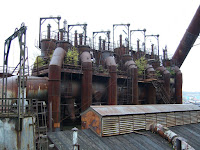The rhythm of industrial production

"Völklingen. Eisen-Werke bei Nacht.
Bildpostkartenserie des Saar-Hilfswerks"
This POST was inspired by Anna's quest for Europe between the East and the West as well as by her choice of a photograph of the Völklingen Ironworks to illustrate her conversation with her parents.
Von allen im 19. und 20. Jahrhundert in Europa und Nordamerika errichteten Hochofenwerken ist es das einzige Werk, das vollständig erhalten ist.
Die Authentizität der technischen Einrichtungen macht es zu einem einzigartigen Denkmal der Industriegeschichte, das seit 1994 zum UNESCO Welterbe der Menschheit gehört.
Anna's father originally comes from the Czech Ostrava region next to the border of Poland. Ostrava is an important centre of steel and coal. Anna herself grew up in Palatinate near the German-French border and discovered "by the way" the crafts(wo)manship of crystall glass carving being practised near her home,"on the other side" of the border, in Lorraine (France), just like in Bohemia.
I was wondering, what Roger White, the passionate archeologist from Great Britain, where "it all" started (the Industrial Revolution), would share his impressions of Völklingen with us.
When he heard about Anna's story, he sent a resume of his thoughts which might as well make us reflect the origins of the European Community of Coal and Steel in the Greater Region :
What do you do when it is all over? When those decades of steel production that lit up the night sky with flame and smoke have vanished? When you step out of the door and no longer smell coal in the air?
There stand the works silent and deserted
where once they bustled with life. The towering structures and nets of
scaffolding are silent without their workforce and the gates are closed.
In the
UK where the painful process of deindustrialisation was often accompanied by
confrontation, anger, but also quiet despair and a paradoxical bringing
together of the community, the government's response was usually to tear the
site away from its landscape. To eradicate the scar of industry, but also
eliminate the evidence of a powerful and often independently minded
cohort of workers. The thorn in the foot gone at last.
Visiting Völkingen is
to reconnect with that gritty, industrial reality. Never pretty, but always
demanding your attention as a place, even shorn of its light, smoke and life.
Once inside its unknown spaces, able to explore, one is confronted by
extraordinary machines, everlasting conveyor belts, banks of enigmatic blocks
of metal with doors that one learns are coke-ovens and, dominating all, the six
fluid and dominating blast-furnace chimneys; all alike - all different, the
rhythm of industrial production.
You wander in a daze through spaces never
before open to humans - huge concrete boxes with doors excised in their walls
containing silent images of World Heritage Sites. You begin to notice
traces of the former workers - their lockers or the place where they hid away
to have their snap - even a packed lunch has it is own special and
intimate terminology.
The little steam engines offer a glimpse of a more human
world, and for the British of a certain generation, a reminder of the
charming children's animation 'Ivor the Engine' (https://en.wikipedia.org/wiki/Ivor_the_Engine).
Look
again, and you begin to notice nature reclaiming its own - the birch trees
growing on the chimneys, buddleia sprouting in profusion in the mineral-rich
dust of the site.
And as you stand on the top of the site and look out,
you still see steel, this time carried in liquid form in special train
transports from the Saarstahl site next door, and realise that the Völklinger
Hütte may be gone but you can't uninvent the need for steel:
The King
is dead - Long Live the King!💙
Greetings from Birmingham (UK),
Roger White
Photos: Völklingen Ironworks, blast furnace complex, by Roger White
💙... and may Her Majesty the Queen live long enough to celebrate the comeback of Great Britain to the European Union!






Kommentare
Kommentar veröffentlichen